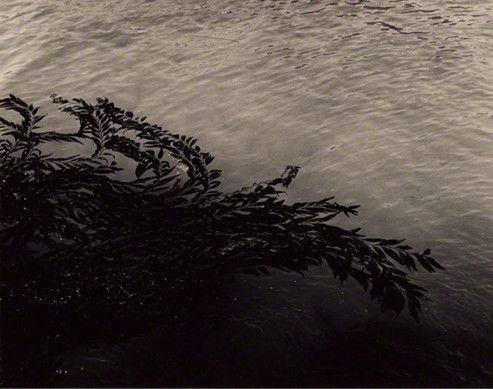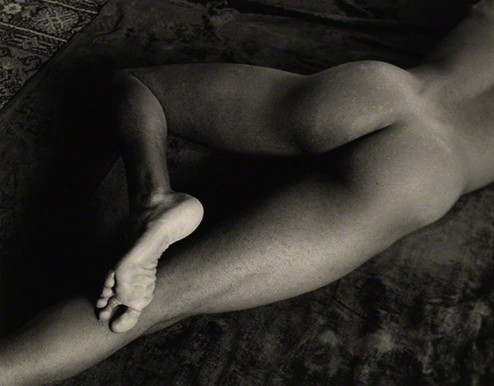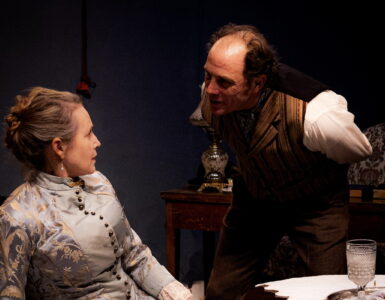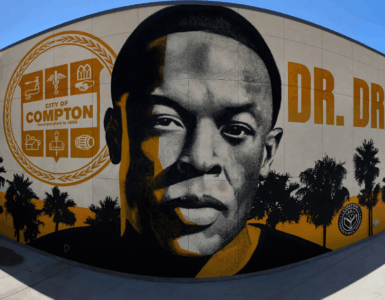
A highly influential figure who was central to modern photography, Minor White (American 1908–1976) pursued a life in photography with great energy and ultimately extended the expressive possibilities of the medium. Controversial, misunderstood, and sometimes overlooked, White was a tireless worker, and his long career as a photographer, teacher, editor, curator, and critic remains central to understanding the history of photographic modernism.
Featuring some never before seen images in this first major retrospective of his work since 1989, Minor White: Manifestations of the Spirit is currently on view at the J. Paul Getty Museum, Getty Center until October 19, 2014. This instructive exhibition was curated by Paul Martineau, associate curator of photographs at the J. Paul Getty Museum.
This summer, through August 29, the Getty Center will stay open until 9 p.m. on Fridays as well as Saturdays, giving visitors another long summer evening to enjoy the art, gardens and view. Current exhibitions include The Scandalous Art of James Ensor, which charts James Ensor’s astonishing artistic development in the decade culminating with his avant-garde masterpiece, Christ’s Entry into Brussels in 1889 (1888), and Minor White: Manifestations of the Spirit, a retrospective exhibition of one of the most controversial, misunderstood, and overlooked 20th century photographers. Also on view will be Convergences: Selected Photographs from the Permanent Collection, Rococo to Revolution: 18th-Century French Drawings from Los Angeles Collections, and Chivalry in the Middle Ages.
On May 30, the Getty Center launches extended Friday hours with Friday Flights, an evening that fuses music, art, discussion and dance. Each Friday Flight includes a collaboration between the Getty and a featured musician or cultural tastemaker who creates a specially curated evening inspired by an exhibition on view. The summer will also include the longstanding music series Saturdays Off the 405, making the Getty a premier destination for free evening music.
The Restaurant will be open for dinner, and the Courtyard Coffee Cart will be open until 8p.m on Friday and Saturday evenings.
Minor White: Manifestations of the Spirit includes recently unearthed photographs from the artist’s archive at Princeton University, recent Getty Museum acquisitions, a significant group of loans from the collection of Daniel Greenberg and Susan Steinhauser, alongside loans from the Museum of Modern Art, New York, the Portland Art Museum, and the Los Angeles County Museum of Art. Also featured is White’s masterly photographic sequence Sound of One Hand (1965).
Minor White is one of the masters of photographic modernism. Throughout his career, White sought to photograph things not only for what they are but also for what they may suggest, and his pictures teem with symbolic and metaphorical allusions. White was a closeted homosexual, and his sexual desire for men was a source of turmoil and frustration. Coming of age when homosexuality was socially unacceptable, White sought comfort in a variety of Western and Eastern religious practices. He confided his feelings in the journal he kept throughout his life and sought comfort in a variety of Western and Eastern religious practices. This search for spiritual transcendence continually influenced his artistic philosophy. Photography became both a way to make visible his ongoing search for spiritual transcendence and a medium through which he could express his sexual desire for men. White’s work was highly influential to a generation of photographers and still resonates today.
“Minor White had a profound impact on his many students, colleagues, and the photographers who considered him a true innovator, making this retrospective of his work long overdue” says Timothy Potts, director of the J. Paul Getty Museum. “The exhibition brings together a number of loans from private and public collections, and offers a rare opportunity to see some of his greatest work alongside unseen photographs from his extensive archive.”
Early Career, 1937–45
In 1937, White relocated from Minneapolis, where he was born and educated, to Portland, Oregon. Determined to become a photographer, he read all the photography books he could get his hands on and joined the Oregon Camera Club to gain access to their darkroom. Within five years, he was offered his first solo exhibition at the Portland Art Museum (1942). White’s early work exhibits his nascent spiritual awakening while exploring the natural magnificence of Oregon. His Cabbage Hill, Oregon (Grande Ronde Valley) (1941) uses a split-rail fence and a coil of barbed wire to demonstrate the hard physical labor required to live off the land as well as the redemption of humankind through Christ’s sacrifice on the cross.
During World War II, White served in Army Intelligence in the South Pacific. Upon discharge, rather than return to Oregon, he spent the winter in New York City. There, he studied art history with Meyer Shapiro at Columbia University, museum work with Beaumont Newhall at the Museum of Modern Art, and creative thought in photography with photographer, gallerist, and critic Alfred Stieglitz (American, 1864–1946).
Mid career, 1946–64
In 1946, famed photographer Ansel Adams (American, 1902–1984) invited White to teach photography at the California School of Fine Arts (CSFA) in San Francisco. The following year, White established himself as head of the program and developed new methods for training students. His own work during this period began to shift toward the metaphorical with the creation of images charged with symbolism and a critical aspect known as “equivalence,” meaning an image may serve as an idea or emotional state beyond the subject pictured. In 1952, White co-founded the seminal photography journal Aperture and was its editor until 1975.
In 1953, White accepted a job as an assistant curator at the George Eastman House (GEH) in Rochester, New York, where he organized exhibitions and edited GEH’s magazine Image. Coinciding with his move east was an intensification of his study of Christian mysticism, Zen Buddhism, and the I Ching. In 1955, he began teaching a class in photojournalism at the Rochester Institute of Technology and shortly after began to accept one or two live-in students to work on a variety of projects that were alternately practical and spiritually enriching. During the late 1950s and continuing until the mid-1960s, White traveled the United States during the summers, making his own photographs and organizing photographic workshops in various cities across the country.
By the late 1950s, at the height of his career, White pushed himself to do the impossible—to make the invisible world of the spirit visible through photography. White’s masterpiece—and the summation of his persistent search for a way to communicate ecstasy—is the sequence Sound of One Hand, so named after the Zen koan which asks “What is the sound of one hand clapping?”
“White’s sequences are meant to be viewed from left to right, preferably in a state of relaxation and heightened awareness,” says Paul Martineau, associate curator of photographs at the J. Paul Getty Museum and curator of the exhibition. “White called on the viewer to be an active participant in experiencing the varied moods and associations that come from moving from one photograph to the next.”
Late Career, 1965–76
In 1965, White was appointed professor of creative photography at the Massachusetts Institute of Technology (MIT), where he developed an ambitious program in photographic education. As he aged, he became increasingly concerned with his legacy, and began working on his first monograph, Mirrors Messages Manifestations, which was published by Aperture in 1969. The following year, White was awarded a Guggenheim Foundation Fellowship, and he was the subject of a major traveling retrospective organized by the Philadelphia Museum of Art in 1971.
Beginning in the late 1960s and continuing until the early 1970s, White organized a series of groundbreaking thematic exhibitions at MIT—the first of which served as a springboard for forming the university’s photographs collection.
In 1976, White died of heart failure and bequeathed his home to the Aperture Foundation and his photographic archive of more than fifteen thousand objects to Princeton University.
The exhibition will also include work by two of White’s students, each celebrated photographers in their own right, Paul Caponigro (American, born 1932) and Carl Chiarenza (American, born 1935).
“An important aspect of Minor White’s legacy was his influence on the next generation of photographers,” says Martineau. “Over the course of a career that lasted nearly four decades, he managed to maintain personal and professional connections with hundreds of young photographers—an impressive feat for a man dedicated to the continued exploration of photography’s possibilities.”

Minor White: Manifestations of the Spirit is on view until October 19, 2014 at the J. Paul Getty Museum, Getty Center.
The exhibition is curated by Paul Martineau, associate curator of photographs at the Getty Museum.
An accompanying publication by Martineau and published by Getty Publications will accompany the exhibition.
The first major retrospective of White’s work since 1989, this exhibition was organized by the J. Paul Getty Museum and includes photographs that are part of a larger group of promised gifts from Los Angeles-based collectors Daniel Greenberg and Susan Steinhauser.
The J. Paul Getty Trust is an international cultural and philanthropic institution devoted to the visual arts that includes the J. Paul Getty Museum, the Getty Research Institute, the Getty Conservation Institute, and the Getty Foundation. The J. Paul Getty Trust and Getty programs serve a varied audience from two locations: the Getty Center in Los Angeles and the Getty Villa in Malibu.
The J. Paul Getty Museum collects in seven distinct areas, including Greek and Roman antiquities, European paintings, drawings, manuscripts, sculpture and decorative arts, and photographs gathered internationally. The Museum’s mission is to make the collection meaningful and attractive to a broad audience by presenting and interpreting the works of art through educational programs, special exhibitions, publications, conservation, and research.
Visiting the Getty Center
The Getty Center is open Tuesday through Friday and Sunday from 10 a.m. to 5:30 p.m., and Saturday from 10 a.m. to 9 p.m. It is closed Monday and major holidays. Admission to the Getty Center is always free. Parking is $15 per car, but reduced to $10 after 5 p.m. on Saturdays and for evening events throughout the week. No reservation is required for parking or general admission. Reservations are required for event seating and groups of 15 or more. Please call (310) 440-7300 (English or Spanish) for reservations and information. The TTY line for callers who are deaf or hearing impaired is (310) 440-7305. The Getty Center is at 1200 Getty Center Drive, Los Angeles, California.
Additional information is available here.Sign up for e-Getty to receive free monthly highlights of events at the Getty Center and the Getty Villa via e-mail, or visit their official site for a complete calendar of public programs.




